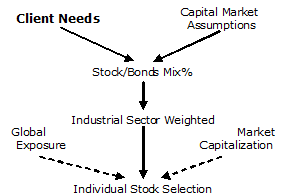SCM designs your portfolio allocation framework, makes the individual stock/fund decisions to match your objectives and places the trades on your behalf in an account held in your name at a large institution such as Charles Schwab. Then we monitor and review the outcome.
SCM takes full discretionary responsibility for constructing and monitoring your customized portfolio for all account types. The strategies and asset allocation selected are consistent with your personal goals objectives. Simpson Capital manages the portfolios based on Modern Portfolio Theory. Visit our Modern Portfolio Theory page for more information.
SCM Portfolio Management Process
Asset class allocation, the most important portfolio decision, is determined by continued assessment of your needs in terms of risk and return. SCM selects top quality, individual issues of equities and fixed-income securities with ‘buy and hold’ intent. Final decisions are based on positive firm fundamentals, industrial sector outlook and expected relative market performance. SCM is neutral to market timing.

At left is a flowchart of the process SCM uses to manage your portfolio. It starts with determining your needs through personal interviews and making assumptions about the future risk/return characteristics of capital asset classes. These profiles are matched and investment guidelines established. Further layers of risk management such as industrial sectors, global exposure and market capitalization are integrated into the portfolio construction.
SCM feels it is possible to enhance your value by using outside manager’s expertise for foreign exposure, based upon SCM’s evaluation of the outside manager’s skill level and performance.
The structure for your account is detailed in customized investment guidelines. Visit our Account Investment Guidelines page for more information. The strategies used are matched to your needs and vary by degree of risk. For more detail on these strategies, visit our Portfolio Strategies page.
Account Investment Guidelines
The purpose of investment guidelines statement is to outline a philosophy and strategy, which will guide the management of your investments toward the desired results. The areas of guidelines are:
- Objectives– lays out the purpose, desired return type and risk tolerance
- Constraints– describes the time horizon, liquidity and income needs, specifies tax status and legal terms and lists unique circumsatances
- Implementation– presents the strategy, asset allocation, foreign exposure and asset vehicles.
For more information about investment guidelines, visit our Account Investment Guidelines page.
Portfolio Strategies
Portfolio strategy is the road map an investor uses to execute a long-term program of investment in capital markets. Below are the strategies SCM uses for your portfolio:
- Balanced Growth- standard portfolio for normal circumstances
- Capital Builder- above average risk tolerance reaching for extra return
- Diversified Aggressive- high risk and high return
- Moderate Risk Growth- below average risk and steady returns
- Income Builder- yield oriented at below average risk
- Value Preservation- low risk with inflation hedge
- Fixed Income or Cash Only- low risk and high liquidity
For more information, visit our Portfolio Strategies page.
Investment Vehicles
Depending on account size and your preference, SCM uses two types of investment vehicles:
- Individual Issues– individual issues of stocks and bonds with smaller positions of foreign ETFs and money market funds. Visit our Individual Issues page for information
- ETFs- Exchange Traded Funds (ETFs) based on indices with no commissions. Visit our ETF page for more information.


